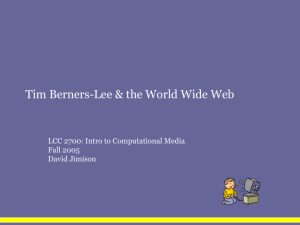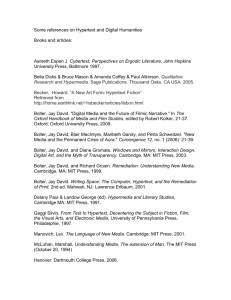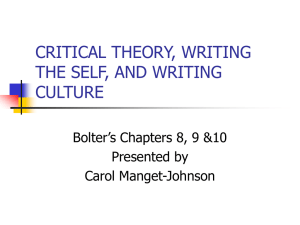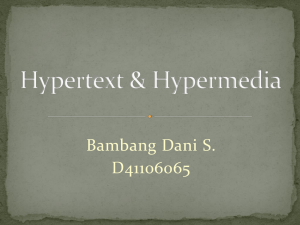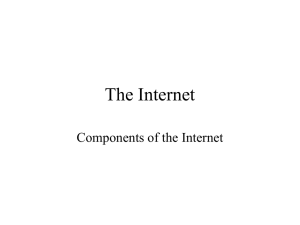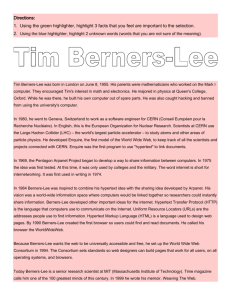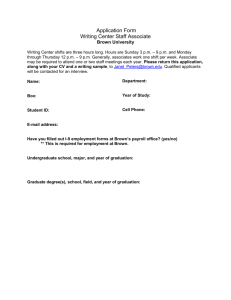Hypertext as an «open work
advertisement
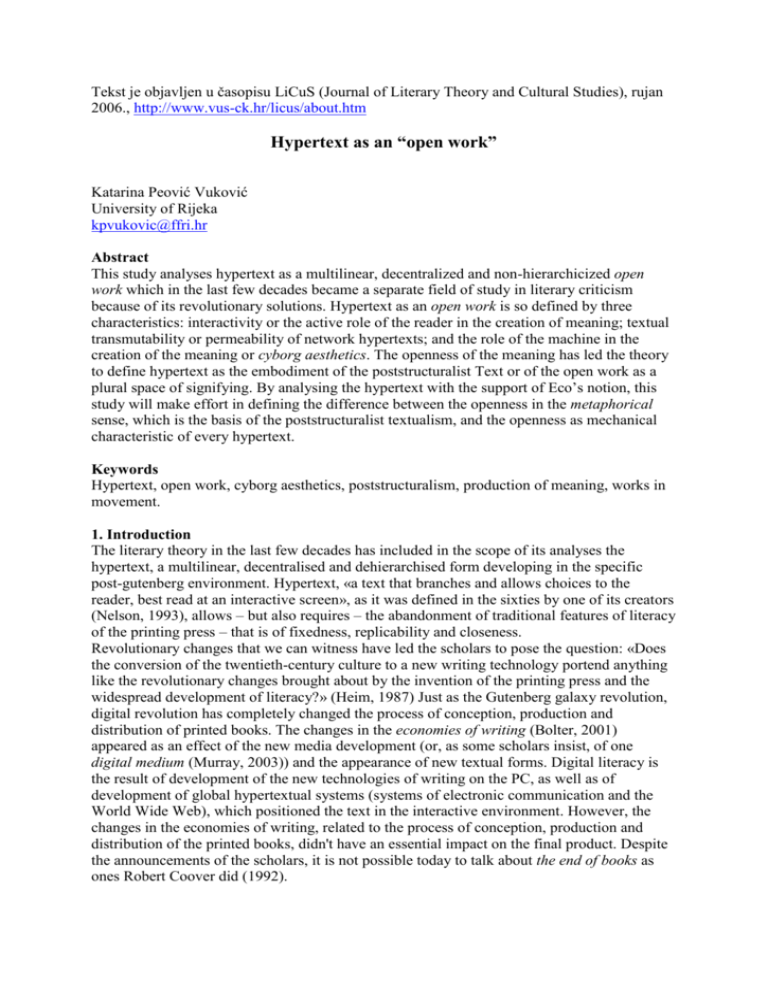
Tekst je objavljen u časopisu LiCuS (Journal of Literary Theory and Cultural Studies), rujan 2006., http://www.vus-ck.hr/licus/about.htm Hypertext as an “open work” Katarina Peović Vuković University of Rijeka kpvukovic@ffri.hr Abstract This study analyses hypertext as a multilinear, decentralized and non-hierarchicized open work which in the last few decades became a separate field of study in literary criticism because of its revolutionary solutions. Hypertext as an open work is so defined by three characteristics: interactivity or the active role of the reader in the creation of meaning; textual transmutability or permeability of network hypertexts; and the role of the machine in the creation of the meaning or cyborg aesthetics. The openness of the meaning has led the theory to define hypertext as the embodiment of the poststructuralist Text or of the open work as a plural space of signifying. By analysing the hypertext with the support of Eco’s notion, this study will make effort in defining the difference between the openness in the metaphorical sense, which is the basis of the poststructuralist textualism, and the openness as mechanical characteristic of every hypertext. Keywords Hypertext, open work, cyborg aesthetics, poststructuralism, production of meaning, works in movement. 1. Introduction The literary theory in the last few decades has included in the scope of its analyses the hypertext, a multilinear, decentralised and dehierarchised form developing in the specific post-gutenberg environment. Hypertext, «a text that branches and allows choices to the reader, best read at an interactive screen», as it was defined in the sixties by one of its creators (Nelson, 1993), allows – but also requires – the abandonment of traditional features of literacy of the printing press – that is of fixedness, replicability and closeness. Revolutionary changes that we can witness have led the scholars to pose the question: «Does the conversion of the twentieth-century culture to a new writing technology portend anything like the revolutionary changes brought about by the invention of the printing press and the widespread development of literacy?» (Heim, 1987) Just as the Gutenberg galaxy revolution, digital revolution has completely changed the process of conception, production and distribution of printed books. The changes in the economies of writing (Bolter, 2001) appeared as an effect of the new media development (or, as some scholars insist, of one digital medium (Murray, 2003)) and the appearance of new textual forms. Digital literacy is the result of development of the new technologies of writing on the PC, as well as of development of global hypertextual systems (systems of electronic communication and the World Wide Web), which positioned the text in the interactive environment. However, the changes in the economies of writing, related to the process of conception, production and distribution of the printed books, didn't have an essential impact on the final product. Despite the announcements of the scholars, it is not possible today to talk about the end of books as ones Robert Coover did (1992). The theory, intrigued by the possibilities offered and changes announced by the emergence of hypertext, has proclaimed it to be one of the most interested new media forms and named it «the embodiement of the semiotic understanding of language and communication» (Bolter, 2001). The convergence of the contemporary literary theory and technology of the new media relies on the usage of common terms such as link, network, web, path, multilinearity, nodes, etc. 2.1. Open (hyper)text The hypertext borrows the models of communication-practices in which none of the participants, neither the writer nor the reader, has the complete control over the text. The crucial role in the shaping of the hypertextual consciousness (as theoretician and writer Mark Amerika (1997) describes this new state) play the spaces of communication systems on the Net (news groups, e-mails, chats, etc.), electronic games, artificial intelligence games (artificial converters), MUD virtual spaces etc. Michael Heim talks about linking, about the network of text (1987), which produces new forms of textuality and communication. It is about the practices of new media communication systems that allow the message to be created in the co-authorship between the sender and the recipient of the message, in which the medium itself can produce (the most often) accidental meanings. The constant networking, re-contextualisation, in the global hypertextual communication, erases the boundaries between different texts. The positions of the author and reader are constantly changing, while neither the sender nor the reader of the message, in the situation of the advancing communication, has the total control over the text. E-mails, for example, often have the fish-bone structure – a sender's message is included in the body of the recipient's reply, the boundaries of the post on a news group or in an e-mail are effaced, it becomes unclear where one text ends and the other begins. The meaning of a hypertext is thus created in the combination of those elements: the author and the programmer, the reader, the text, but even the digital environment. The active role of the reader, the changeability of the text and the role of the digital environment itself in the creation of the meaning has led the theory to deal with hypertext as an «open text» which marks the end of the sovereignty of the author as authority. 2.2. The author and the programmer Not only author but also the programmer participates in the creation of meaning (sometime it is the same person). David Bolter mentions the instance of programmer as neglected (2001). The author/programmer creates the text (or better – the text modules), but also creates possibilities to create many versions of text. We could say that the first instance is the basic one. But author and authorship are instances that went through many changes in digital environment. 2.3. The reader The author of a hypertext includes the reader in the process of creation, offering to the reader different levels of cooperation. From the selection of the reading sequence, in which such a selection necessarily constructs the meaning, to the re-shaping and widening of the text (as in Deene Larsen's poem Marlbe Springs (1993), where readers can add their remarks and fill the empty spaces with their own texts and links). Michael Joyce (1992) defines this function as interlocutor, the author-reader – which guarantees two-wayness of communication. 2.4. The (digital) text The openness of the hypertext is also the result of the «radical (root) instability and promiscuity of inscriptions digitally encoded, stored, retrieved» (Kaplan, 1995). Hypertexts on the Net offer a wide variation of forms of textual manipulation. While the printed text is fixed and complete, and its borders end at the covers, web hypertext erases the borders between itself and other texts, and digital environment as a whole. A digital incorporeal book abolishes the separation and sigle-voiceness of the text. While the printed text produces the effect of expressive self-sufficiency, and it cannot be directly reacted upon, «the author cannot be reached » (Ong, 1982), the hypertext blurs the difference between «the inside» and «the outside». Stuart Moulthrop gives the example of a student who tried to mark textual layers in Borges' Garden of Forking paths (1997). The student created separate cathegories for the original text, for the imitator’s, additional material, but also introduced his own introductory text about hypertext. His intervention became the part of the text it wanted to explain and tame, so instead of classification of textual layers, one additional, author’s, meta- layer was added, which became the part of the Garden1. It is about layers (similar to postmodern metalayers – discovered manuscripts, notes of researchers etc.), which multiplied to paroxysm by the permeability of the borders of the «author's» text what makes the text independent, unstable and open for all additional inscriptions. George Landow rightly concludes that a document, once overlinked by an electronic text, does not exist any more for itself (1992). Each document in the network system that supports electronically linked materials potentially exists in the collaboration with some other and all other documents in that system. Different from a fixed and unchangeable printed text, hypertext is a model of the text which functions as musical notes do. The user can move in different directions, depending on his or her choices, and each choice is (by a software program) transformed into different narrative sequence. A program code, created by the programmer in collaboration with the author, offers to the reader a program for production of meanings. Every reading is just one variant of the text. 2.5. The digital environment But hypertextual meaning is not created only in the collaboration between the author, programmer, and reader. In its production participates also its digital environment. Until today materialized only in experimental texts (or in accidental printed mistakes), the «close externality» - the accidental and unpredictable – becomes the features of the (literary) hypertext. The author loses control over his or her work, which literary becomes a machine for the production of meaning. Espen Aarseth, who the aesthetics of hypertext names cyborg aesthetics – explains how, instead of the text being a chain of signifiers, as defined by linguistics and semiotics, (hyper)text becomes a machine for production of meaning, «not metaphorically but as a mechanical device for the consumption of verbal signs» (1997). Such a mechanical model shapes a triangle which connects a medium, units of meaning (images, sound, etc.) and an operator, a user, who realizes the meaning «in cooperation» with the machine. Even if programmer or author created the textual machine they can’t control every variant of text. An extreme paragon of cyborg aesthetics is any machine-generated work. In John Cayley's Book Unbound (1995), a machine modulated poetry, a program (Hypercard), based on a defined program algorithm, draws up lines from the «initial» text and words of the reader/author. The poems are product of interaction of readers with the program and fragments of the initial, Cayley's material. 1 In his web version of study Writing Space, David Bolter encourages his readers to change his text. However, not even the lines of instructions on how to make free changes cannot escape the mise en abime paradox, as they also can be a result of such making of changes. 3.1. The Convergence of Contemporary Critical Theory and Technology Differences between the printed and electronic «book» materialize the ideas of the poststructuralist textualism that preferred the text as a scene for the production on which the producer and the reader meet. Differentiation of the Work as a fixed, closed, completed object which can occupy physical space, from the Text, which for poststructuralists represents a plural space of signifying, embodies the difference between the printed, as closed text, and electronic text which is experienced only the practice of the production of meaning. While a printed book does not represent only the text, but also a thing, an object, an electronic «book», by its non-materiality, embodies the expression of a fluid shape. Hypertext is seen as embodiment of Barthes’ distinction between “readerly” and “writely” text (1975), difference between printed text as closed text and digital text, which is experienced only in activity of production of meaning. Integrity and stability are features generally attributed to a printed text, and the changes of the text in a book can only be unintentional, accidental, plagiarism or subversions, as is the case, for example, with Burroughs' cut-up, Kathy Acker's plagiarisms, or experiments of contemporary literary American movement called “avant-pop” (avant-pop is using elements of different genres to create post-postmodern art with different media approaches). But those works of print culture proves that even the digital media isn’t crucial in the hypertextual design. The tradition of “experiment” in literature that tried to escape the linear order of book organization implemented the hypertextual elements before technological shift. So cooled proto-hypertexts are linking tradition of hypertextual literature with classical works of print culture. Comparisons go all the way to Sterne's Thristam Shandy, Mallarmé's poem Un coup de dés, Borges' stories that introduce plots that are mutually incompatible, Apollinaire's «calligrammes», Raymond Queneaue’s A hundred thousand billion poems, etc. 3.2. A model for production of meaning The hypertextual meaning, however, different from unintentional or subersive acts, is literary, in non-metaphorical sense, perpetualy constructed from the beginning in every single process of reading. The mechanical openness and uncompleteness of the hypertext is different from the metaphorical openness of the meaning inscribed by the author in his or her work, which was often subject of postructuralist analyses. Namely, while the author of a «traditionally» written work, as well as the author of any hypertext, do not participate in the production of all meanings of the text that result from every single reading (the first, in comparison with the latter, will have some elementary control over the materiality of the text), the author of a hypertext consciously chooses the loss of control. The hypertextual author does not create the text in a traditional meaning. The author actually creates a model, a pattern for production of meaning, and never has a total control of the final forms of «his» or «her» texts. The meaning is literary conceived in the process of reading, by the combination of its parts. There must be noted that we should escape any technological determinism and conclude that technology is not crucial in hypertextual organization. Mixed paragraphs of Julio Cortazar's Hopscotch, as more radical mixed pages of Marc Saporta's Composition No. 1 (a novel consisting of about 150 unnumbered, loose sheets of paper) showed that we can’t substitute the media over the structure. Hypertext as a model for production of meaning exists as structural possibility from pre-technological era. Any such “experiment” proves that print can’t be seen as a natural form of writing. No matter is it a digital or printed work – any hypertextual art can be seen as an open work. 4. Eco's open work Due to obvious similarity, the notion of Umberto Eco's «open work» (1962) imposed itself as one of metaphors of «embodiment» of hypertext. Espen Aarseth, although being critical towards theoretical practices based on the poststructuralism of Derrida, Bahtin, Deleuze, Guattari and others, promotes this notion introduced by Eco, and considers it to be a thematization which takes textual machines in non-metaphorical sense, using it to define every single cybertext (the term that Aarseth uses is somewhat broader, and comprises also the hypertextual works). The subjects of Umberto Eco's study are phenomena of poetry, music, and informel paintings in which, as Eco claims, the structure of the artistic work reflects an (open) «structure of the world» (1962). Contemporary works of art, such as Joyce’s work or Kafka’s work, are characterized by uncertainty and ambiguity of interpretation that is result of symbols, calembours, puns, elliptic plots etc. Such works, Eco claims, signify the refusal of the totality of things and symbolize a new point of view to the universe. However, something that the theory of hypertext often neglects is the fact that the subject of Eco's study are exactly those works whose openness is not based on the literal disappearance of borders. Fluidity, indeterminateness, ambiguity of such works is a result of subsequent interpretative acts and in that sense Eco's works are open exactly in the metaphorical sense. What hypertext and an open work have in common is that they both play with interpretation – it is all about poetics that allow different, and even opposed meanings. But the ways of «opening» of those meanings are essentially different. In hypertext it is a matter of «mechanical», literal openness. Every hypertextual work is actually a set of works – numerous variants of the (same) work. The author of hypertext creates a model that allows different final forms of «her» work. It should not be forgotten however that the author of hypertext decides about the «degree of openness», and in that sense the authority of the author is redefined, but somehow established again. There is a difference between hypertexts in a structural sense: while some represent different variants in regards to the order and sequence of lexems, other inscribes in the programmatic code different solutions in regards to the reader's choices. The openness of the hypertext, different from the printed text, is not embedded (only) in the openness of meaning, which is the characteristic of every interpretative act. In that sense, every work can be seen as hypertextual work – no matter on which material is reproduced. As we saw before, every nonlinear organization that incorporates author, text, and environment in the creation of meaning, can be hypertextual. Eco himself is also aware of the difference between the metaphorical and mechanical openness, and thus makes difference between «open works» that reflect the «structure of the world», whose openness is product of interpretation, and «works in movement». Works in movement are «[o]ne limited group of works», which are specific «because of their ability to acquire different unpredictable, physically unperformed structures» (author's italics). The works in movement consists of non-planned or physically incomplete structural units – Eco gives an example of something similar to hypertext – musical practice in which the performer needs to chose a sequence from more offered alternatives. Eco also gives an example of Mallarmé’s unfinished work entitled Livre. Eco claims that Mallarmé used a combined mechanics, in which grammatical, syntactical and typographical order of the text introduced a certain polymorphous plurality. In Livre, pages would not follow in order, but would be connected by the laws of permutation: pages are not binded, they are mobile and interchangeable, collected in several folders. There are an astronomical number of textual combinations. Unpredictable and physically unperformed structures are also hypertextual structures. Eco's works in movement define more precisely incompleteness and openness of hypertextual poetics. Musical scores or notations that offer several variants to a musician, are often used by the theoreticians of hypertext as an analogy, since hypertext is indeed a model which enables different «performances» depending on different selections by the reader or on the programmatic code of the machine. There is no reason to elaborate the similarity of Mallarmé’s unfinished work and works of so called proto-hypertext such as Marc Saporta's Composition No. 1 which will link the works of non-technological era with digital works. Eco example shows that experiments with form of printed text were always some kind of questioning of media that is assumed to be “natural”. From diagrams, blind pages and paragraphs with only few lines in Sterne's Thristam Shandy, to Mallarmé’s Livre (or one Mallarmé's materialized work poem Un coup de dés) and Composition No. 1 experiments “disturbed” the linear order of print. 5. Conclusion Although some poststructuralist categories such as Eco's open work (as well as Barthes' Text) are close to hypertextual poetics, their use is often limited. In that sense, Arseth's remark about the convergence of critical theory and technology being at the same time an effort of legitimization of the field that produced several seminal essays, but didn't help the understanding of the hypertext, is accurate (1997). Before the appearance of hypertext, the poststructuralist textualism described a model of the text as a fluid field of signifying, but the openness of the meaning defines only one aspect of the hypertext. Eco's notion of open work thus defines signifying openness and interpretative indeterminateness, while the hypertextual openness is (also) a result of combinatory, formal variability of the text. The openness of meaning of hypertextual work is not only the result of interpretation, but also ensues from characteristics of the hypertextual medium itself: interactivity (the role of the reader similar to that of the author), machine modulation (the role of the machine) and transmutability of the text (the role of the network environment). The accent therefore should be put on the openness in a non-metaphorical sense (and in that Eco's notion of the work in movement defines more precisely the hypertextual poetics), which relies on interaction, machine modulation and textual transmutability. 6. References Aarseth, Espen (1997) Cybertext: Perspectives on Ergodic Literature, Baltimore: Johns Hopkins University Press Amerika, Mark (January, 1997) «Hypertextual Consciousness», American Book Review (URL: http://www.altx.com/htc1.0/) Barthes, Roland. S/Z. An Essay. Hill and Wang, 1975. Bolter, Jay David (2001) Writing Space: Computers, Hypertext, and Remediation of Print, N.J.: Lawrence Erlbaum Associates Cayley, John (1995) Book Unbound (www.demon.co.uk/eastfield/in) Coover, Robert (June, 1992) «The End of Books». New York Times Review of Books Eco, Umberto (1962) Opera aperta: Forma e indeterminazione nelle poetiche contemporanee. Milano Hayles, N. Katherine (1999) How We Became Posthuman: Virtual Bodies in Cybernetics, Literature, and Informatics, Chicago & London: The University of Chicago Press Heim, Michael (1987) Electric Language: A Philosophical Study of Word Processing, New Haven & London: Yale University Press Joyce, Michael (1992) «Notes Toward an Unwritten Nonlinear Electronic Text, 'The Ends of Print Culture'», Postmodern Culture, Vol. 2, No. 1 Kaplan, Nancy (March, 1995) «E-literacies: Politexts, Hypertexts, and Other Cultural Formations in the Late Age of Print», Computer-Mediated Communication Magazine, Vol. 2, No. 3, (URL: http://www.ibiblio.org/cmc/mag/1995/mar/kaplan.html Landow, George (1992) Hypertext: The Convergence of Contemporary Literary Theory and Technology; Baltimore & London: Johns Hopkins University Press Larsen, Deena (1993) Marble Springs, demo version, Cambridge, Mass.: Eastgate Systems (URL: http://www.eastgate.com/catalog/MarbleSprings.html) Moulthrop, Stuart (1997) «Pushing Back: Living and Writing in Broken Space», Modern Fiction Studies 43(3) Murray, H. Janet (2003) «Inventing the Medium», The New Media Reader, ed. Noah Wardrip-Fruin and Nick Montfort, Cambridge, Massachutsetts/ London, England: The MIT Press Nelson, Theodor H. (1993) Literary Machines. 93.1, Sausalito CA: Mindful Press Ong, J. Walter (1982) Orality and Literacy: The Tehnologizing of the World, New York & London: Routledge

